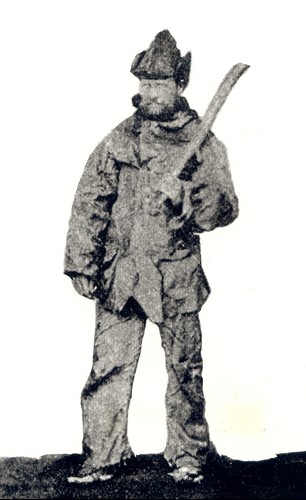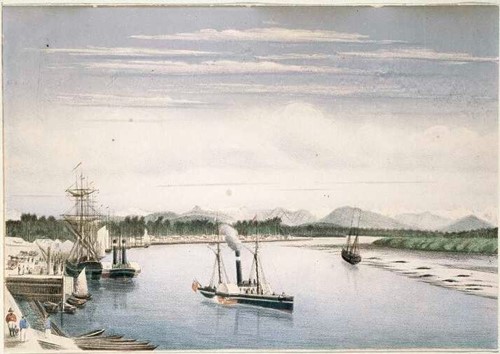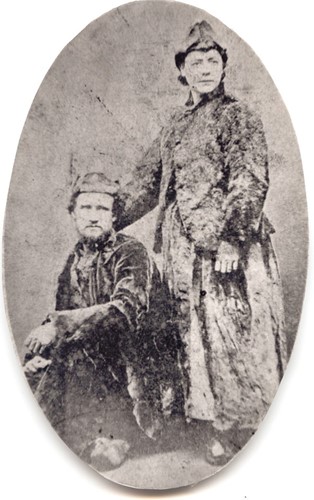Lord of the Seals
The Biography of James Teer
On the night of May 14th, 1866, the American ship the “General Grant” sank to the bottom of the ocean leaving one woman and fourteen men stranded on the Auckland islands. Our story today focuses on James Teer, one of the survivors of the shipwreck, his life, and how he led the group for over 18 months.

James Teer in his sealskin outfit, #008403
James Teer is believed to have arrived in New Zealand in the 1860s. He worked a canoe and acted as pilot for various ships coming into the river. James first came to prominence in New Zealand on Dec 20th, 1864, when he piloted the first paddle steamer called the “Nelson” across the bar into the Hokitika river. One account recalls how the sea was “as smooth as glass” and that he alone “piloted the vessel in safely”. Despite this, an ongoing grievance James had was being denied the job of harbormaster for Hokitika. It aggravated him and was likely a factor for his eventual departure.

Port of Hokitika by W.M. Cooper, [Ref: A-104-025-a. Alexander Turnbull Library, Wellington, New Zealand. /records/22309766’]
James found work around Australia and New Zealand in remote areas goldmining. He joined the West Coast goldrush and found moderate success. After 20 years of working as a miner, mariner, and boatman and building a modest wealth for himself, James booked a journey home to Ireland in 1866 on the S.S “General Grant”; a wooden vessel which housed valuable cargo, most famously gold, and many people aboard. On May 4th, the ship left from Melbourne and set sail to London. Ten days later, however, the ship experienced a terrible slew of events that sent it hurtling towards towering cliffs and into a cavern on the Auckland Islands
Of the 83 lives on the ship, only 15 would survive the wreck. Amongst the survivors were of course James Teer, and married couple Mary Ann and Joseph Jewell. They made their way to one of the Auckland Islands on a small boat that survived. Unfortunately, the boat was swamped when attempting berth. Despite having the chief officer (Bart Brown) in the group, it was James who took leadership. He was resourceful, experienced with the sea and previous shipwrecks, and although his disciplinary actions were harsh, James was always a fair leader.
The first act of survival was making a fire. By sheer luck, a member possessed a box of matches, but of the six contained only one was lit. From it, a fire was made and stayed ablaze for their whole duration on the island. They survived off small birds, fish, and a few tins of broth initially, but James’ ingenuity allowed them to craft six blades out of a single shovel blade and a hook on a pole to capture other animals. They hunted pigs and goats, but seals became their staple diet. He found a way to soften and dry their skin, and crafted needles and thread from flax and albatross bones. With the help of Mary Ann Jewell, they fashioned clothing for the group. trousers and jackets were made for the men and for Mary Ann, a sealskin dress.
James Teer was vital in keeping the survivors together and in check. Routines were formed consisting of watching the fire and maintaining a lookout for passing boats. When scurvy befell the group, he forced them all to exercise. When Mary Ann Jewell was harassed by another man, James was the one who ended the ordeal. It’s reported he had a diary of sorts made from dried seal skin where he mainly kept a calendar and daily reports.
Four attempted to find New Zealand on a makeshift boat but were never seen again. Later, one died on one of the Auckland Islands due to sickness. The 10 survivors were rescued on Nov 21, 1867, by a whaling brig under the command of Captain Gilroy. Because their diet was primarily seal, they were rather chubby. They spent nearly two years stranded, and finally returned to civilization on Jan 13, 1868, to Invercargill.

Joseph and Mary Ann Jewell, #010587
Attempts were made to find the General Grant later with several accounts stating James Teer participated in these expeditions. But they were all unsuccessful, and to this day the location of the General Grant and all its gold remain a mystery .James and the group returned virtually penniless after the whole ordeal and were unable to be given help due to being foreigners. But they earned a living retelling their story, donning their sealskin garments for effect.

James Teer's sealskin hat, P420.75 Teer Sealskin Hat
James returned to the West Coast dressed in his sealskin costume to give lectures to mining communities about his life as a castaway. James Teer’s sealskin hat is held by Hokitika Museum today.
It’s unknown whether the hat was made during his exile or afterwards. James later returned to Hokitika working as a boatman in 1874, but settled down a year after in Arawhata, Jackson Bay working as a fisherman. He assisted a family with food such as small birds and got in trouble with locals for hunting seals out of season, seemingly having grown a liking for their meat.
He died on April 30th, 1887, and was buried in Arawhata cemetery. During his burial, a bottle of whisky was poured over his coffin as a sign of respect.
